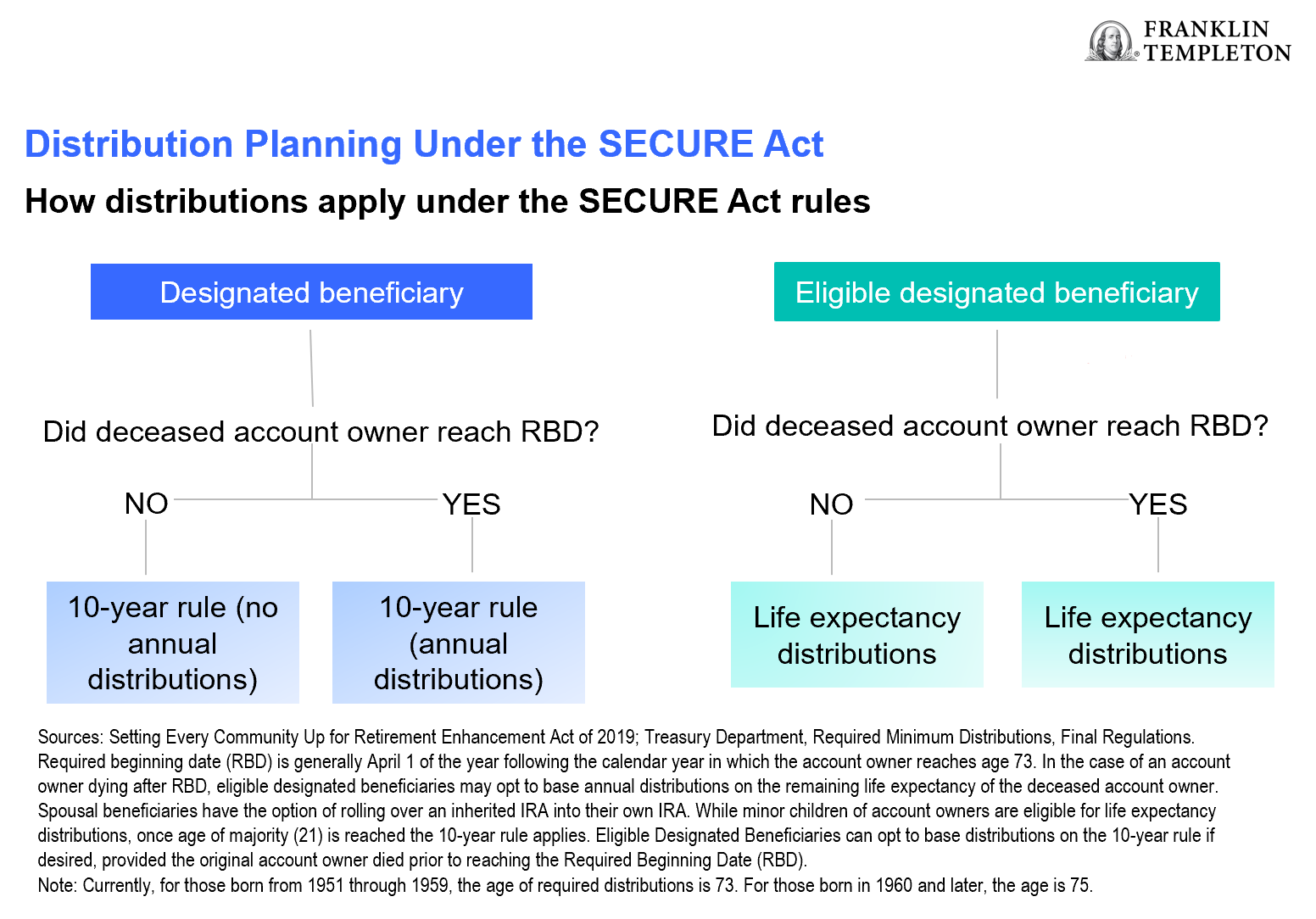Individuals with inherited retirement accounts received some long-awaited clarity on the “10-year rule” for account distributions when the Treasury Department issued final regulations in July. The 10-year rule refers to the passing of an individual retirement account to a beneficiary wherein the beneficiary must withdraw the funds within 10 years.
Despite some new clarity on this rule, many heirs still have questions on how to proceed.
One of the primary questions is whether someone subject to the 10-year distribution rule has to take annual distributions in addition to withdrawing all the funds within 10 years.
Understanding the age of the account owner is key
The key variable to understand the rule depends on when the original account owner passed away. That is, did the account owner reach their required beginning date (RBD) before death?
Generally, the RBD is April 1 after the calendar year when the account owner reaches age 73. If the owner passed away after reaching their RBD then, absent any exception, the beneficiary is subject to an annual distribution requirement based on their life expectancy in addition to the 10-year requirement.
- There is an exception for eligible designated beneficiaries (EDBs). These types of beneficiaries include spouses, individuals with disabilities or those who are chronically ill, beneficiaries not more than 10 years younger than the account owner, or minor children of the account owner (up to age 21 upon which the 10-year rule applies).
- Instead, EDBs have the option to take distributions gradually each year based on their remaining life expectancy.
- Other beneficiaries, such as non-spouse beneficiaries where an exception does not apply, are referred to as designated beneficiaries and are subject to the 10-year distribution rule.

Beneficiary designation has an impact
The implementation of the 10-year distribution rule can vary. Here are some examples of how the rules apply in different situations when the beneficiary is a designated beneficiary subject to the 10-year distribution rule:
 1. Account owner dies this year, prior to reaching their RBD
1. Account owner dies this year, prior to reaching their RBD
✓ In this example, IRA owner Roger passes away in 2024 at age 70.
✓ Even though he has been taking periodic distributions from his IRA he has not reached his RBD.
✓ For the heirs, the first step is determining whether a year of death RMD must be taken.
✓ Since Roger died prior to reaching his RBD no RMD for 2024 applies.
✓ Sarah inherits the account, which must be fully distributed by the end of the 10thyear following the year Roger died (by the end of 2034). She has the flexibility to distribute the account as she chooses, provided she complies with the 10-year rule.
 2. Account owner dies this year and has already reached their RBD
2. Account owner dies this year and has already reached their RBD
✓ In this scenario, IRA owner Jessica passes away in 2024 at the age of 80 and has been taking required distributions for several years.
✓ Her daughter Jill is subject to the 10-year rule AND must (at least) take annual distributions for the first nine years (she can always withdraw more if she wants to but is subject to a minimum requirement).
✓ The year of death RMD for Jessica must be taken in 2024, and the 10-year “clock” begins in 2025. In that year, at a minimum, Jill must take an annual distribution based on her remaining life expectancy.
✓ To determine the amount of the annual distribution Jill consults the IRS single life expectancy table.
✓ For example, if Jill is 50 years old her life expectancy factor from the IRS table is 36.2. To calculate the minimum distribution, she determines the account value as of December 31 of the previous year and divides that balance by 36.2.
✓ For each subsequent year’s minimum distribution, she subtracts one from her life expectancy factor and repeats the process (the divisor for the second year’s distribution would be 35.2 and so on).
✓ The inherited account must be fully distributed by the end of 2034.
 3. Account owner died in 2021 after reaching their RBD
3. Account owner died in 2021 after reaching their RBD
✓ In this example, David passed away in 2021 at the age of 87 leaving his IRA to his son Will.
✓ Since David had already reached his RBD and was taking required distributions, a year of death RMD was taken in 2021.
✓ Will has not taken any distributions from the inherited IRA yet since the IRS provided relief for heirs subject to the 10-year rule while regulations on the 10-year rule were proposed but not finalized yet (regulations were first proposed in 2022 and not finalized until recently, see IRS guidance for more details).
✓ In its announcement of relief, the IRS stated while these regulations were pending, a penalty for heirs not taking an annual distribution would not apply for years 2021, 2022, 2023, and 2024.
✓ Beginning in 2025, Will must, at a minimum, begin required distributions based on his life expectancy by consulting the IRS single life expectancy table (similar to the example with Jill).
✓ However, he must calculate his annual distributions on the assumption that he actually took his first distribution in 2022, the year after his father died.
✓ This means that he would consult the IRS table based on his age in 2022, subtract one from that figure for both 2023 and 2024, and then subtract one again to determine the divisor to calculate the minimum distribution for 2025.
✓ Essentially, the calculation for his 2025 distribution and future minimum distributions assumes that Will has already been complying with the annual distribution requirements.
✓ While the IRS provided relief for heirs of inherited retirement accounts for the past few years, the original 10-year period based on when the account owner died still applies.
✓ This means that, at a minimum, Will has to take annual distributions from the inherited IRA for the years 2025 through 2030 with a full distribution by the end of 2031.
Seek expert advice
Given the complexity of these distribution rules, beneficiaries may consider consulting with their tax professional and financial advisor for expert advice before proceeding. For more detail on these new distribution rules and ideas on how to mitigate the impact of the 10-year rule consult our piece, “Distribution Planning under the SECURE Act.”
WHAT ARE THE RISKS?
All investments involve risks, including possible loss of principal.
Any information, statement or opinion set forth herein is general in nature, is not directed to or based on the financial situation or needs of any particular investor, and does not constitute, and should not be construed as, investment advice, forecast of future events, a guarantee of future results, or a recommendation with respect to any particular security or investment strategy or type of retirement account. Investors seeking financial advice regarding the appropriateness of investing in any securities or investment strategies should consult their financial professional.
Franklin Templeton, its affiliated companies, and its employees are not in the business of providing tax or legal advice to taxpayers. These materials and any tax-related statements are not intended or written to be used, and cannot be used or relied upon, by any such taxpayer for the purpose of avoiding tax penalties or complying with any applicable tax laws or regulations. Tax-related statements, if any, may have been written in connection with the “promotion or marketing” of the transaction(s) or matter(s) addressed by these materials, to the extent allowed by applicable law. Any such taxpayer should seek advice based on the taxpayer’s particular circumstances from an independent tax advisor.
IMPORTANT LEGAL INFORMATION
This material is intended to be of general interest only and should not be construed as individual investment advice or a recommendation or solicitation to buy, sell or hold any security or to adopt any investment strategy. It does not constitute legal or tax advice. This material may not be reproduced, distributed or published without prior written permission from Franklin Templeton.
The views expressed are those of the investment manager and the comments, opinions and analyses are rendered as at publication date and may change without notice. The underlying assumptions and these views are subject to change based on market and other conditions and may differ from other portfolio managers or of the firm as a whole. The information provided in this material is not intended as a complete analysis of every material fact regarding any country, region or market. There is no assurance that any prediction, projection or forecast on the economy, stock market, bond market or the economic trends of the markets will be realized. The value of investments and the income from them can go down as well as up and you may not get back the full amount that you invested. Past performance is not necessarily indicative nor a guarantee of future performance. All investments involve risks, including possible loss of principal.
Any research and analysis contained in this material has been procured by Franklin Templeton for its own purposes and may be acted upon in that connection and, as such, is provided to you incidentally. Data from third party sources may have been used in the preparation of this material and Franklin Templeton (“FT”) has not independently verified, validated or audited such data. Although information has been obtained from sources that Franklin Templeton believes to be reliable, no guarantee can be given as to its accuracy and such information may be incomplete or condensed and may be subject to change at any time without notice. The mention of any individual securities should neither constitute nor be construed as a recommendation to purchase, hold or sell any securities, and the information provided regarding such individual securities (if any) is not a sufficient basis upon which to make an investment decision. FT accepts no liability whatsoever for any loss arising from use of this information and reliance upon the comments, opinions and analyses in the material is at the sole discretion of the user.
Products, services and information may not be available in all jurisdictions and are offered outside the U.S. by other FT affiliates and/or their distributors as local laws and regulation permits. Please consult your own financial professional or Franklin Templeton institutional contact for further information on availability of products and services in your jurisdiction.
Issued in the U.S. by Franklin Distributors, LLC, One Franklin Parkway, San Mateo, California 94403-1906, (800) DIAL BEN/342-5236, franklintempleton.com – Franklin Distributors, LLC, member FINRA/SIPC, is the principal distributor of Franklin Templeton U.S. registered products, which are not FDIC insured; may lose value; and are not bank guaranteed and are available only in jurisdictions where an offer or solicitation of such products is permitted under applicable laws and regulation.
Please visit www.franklinresources.com to be directed to your local Franklin Templeton website.

